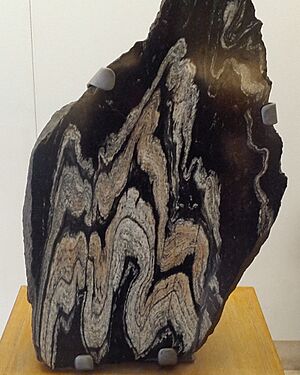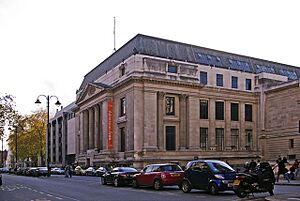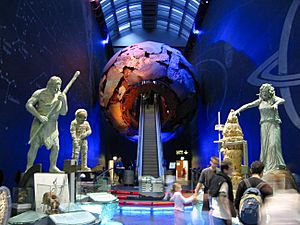Geological Museum facts for kids
The Geological Museum was a special museum in London that focused on geology, which is the study of Earth's rocks and history. It first opened its doors in 1835. This makes it one of the oldest public museums in the world dedicated to a single science.
The museum originally started as the Museum of Economic Geology. Later, it was known as the Museum of Practical Geology. In 1935, it moved from Jermyn Street to a new building on Exhibition Road in South Kensington. This new building was right next to the famous Natural History Museum. Today, the Geological Museum is actually part of the Natural History Museum.
Contents
A Look Back: The Museum's Journey
How the Museum Began
The Museum of Economic Geology was created in 1837. It was first located at 6 Craig's Court in Whitehall, London. The idea for the museum came from Henry de la Beche. He was the very first director of the British Geological Survey, which studies the geology of Britain.
De la Beche also started the museum's library in 1843. He mostly donated books from his own collection. The museum's management moved to a different government department in 1845.
Soon, the museum needed a bigger space. So, a new building was designed by James Pennethorne. This new building was called the Museum of Practical Geology. It was built between 1845 and 1849. The new museum was officially opened by Prince Albert on May 14, 1851.
The main goal of the museum was to show off rocks, minerals, and fossils. These items helped explain the maps made by the Geological Survey. It also showed how minerals found in the UK could be used for practical things and for beauty.
The museum's collections were set up in different sections. Some showed natural materials from the UK. Others displayed products made from these materials. There were also sections for tools, historical items, and raw materials from other countries. The museum even had maps, mosaics, glass, and pottery. In 1901, many decorative items were moved to the Victoria and Albert Museum.
Moving to Exhibition Road
The museum reopened in its new home on Exhibition Road in July 1935. The new building had been finished two years earlier. Before the museum moved in, the building hosted the World Economic Conference in 1933. This meeting tried to solve a big global economic problem, but it didn't succeed. The new building cost about £220,000 to build.
After the move, the museum became famous for its many dioramas. These were three-dimensional scenes that helped explain geology and mining methods. Most of these dioramas have been taken apart since the Natural History Museum took over in 1986.
In 1965, the museum joined with other geological groups. It was then called the "Institute of Geological Sciences." In 1971, a designer named James Gardner helped create an exhibition called The Story of the Earth. This exhibit was a huge success and changed how science museums designed their displays.
Queen Elizabeth II opened The Story of the Earth. It was known for a giant copy of a rock face from Scotland. It also featured a planetarium, a model of an active volcano, and an earthquake machine.
Between 1971 and 1974, the museum created its own design team. This team worked with scientists to make many new exhibitions. These included Britain Before Man, Journey to the Planets, and Treasures of the Earth. The British Offshore Oil and Gas exhibition opened in 1988.
Treasures of the Earth was one of the first museum galleries to use computers. These computers showed pictures and text next to the real objects. This helped visitors learn more about the exhibits.
Becoming Part of the Natural History Museum
By 1985, the Geological Museum's galleries and collections moved. They became part of the independent Natural History Museum (NHM). The galleries were renamed The Earth Galleries.
In 1996, the main hall of the old museum was completely changed. A designer named Neal Potter created a new look. A large escalator was installed, rising through a model of the Earth. This globe rotated around the escalator with exciting sound effects. It was meant to show the movement inside our planet.
The escalator was added because visitors often didn't go up the old museum's big staircase. Now, visitors are encouraged to start their visit at the top of the building. They ride the escalator up as part of their tour.
The open balconies in the main hall were replaced with solid walls. These walls are covered with recycled slate. Stars and planets of our Solar System are sand-blasted onto the slate.
In 1998, a new link gallery was built. This made it easier to walk between the Natural History Museum and the former Geological Museum buildings.
Today, the old Geological Museum galleries are known as the Red Zone within the NHM. In 2014, the displays in the center of the main hall were removed. They were replaced by a real skeleton of a stegosaurus dinosaur. The next year, a new gallery about human evolution opened.
See also
- Museum Lane





